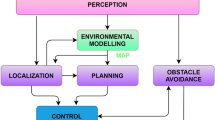Abstract
The development of autonomous mobile machines to perform useful tasks in real work environments is currently being impeded by concerns over effectiveness, commercial viability and, above all, safety. This paper introduces a case study of a robotic excavator to explore a series of issues around system development, navigation in unstructured environments, autonomous decision making and changing the behaviour of autonomous machines to suit the prevailing demands of users. The adoption of the Real-Time Control Systems (RCS) architecture (Albus, 1991) is proposed as a universal framework for the development of intelligent systems. In addition it is explained how the use of Partially Observable Markov Decision Processes (POMDP) (Kaelbling et al., 1998) can form the basis of decision making in the face of uncertainty and how the technique can be effectively incorporated into the RCS architecture. Particular emphasis is placed on ensuring that the resulting behaviour is both task effective and adequately safe, and it is recognised that these two objectives may be in opposition and that the desired relative balance between them may change. The concept of an autonomous system having “values” is introduced through the use of utility theory. Limited simulation results of experiments are reported which demonstrate that these techniques can create intelligent systems capable of modifying their behaviour to exhibit either ‘safety conscious’ or ‘task achieving’ personalities.


















Similar content being viewed by others
Explore related subjects
Discover the latest articles and news from researchers in related subjects, suggested using machine learning.References
Albus, J.S. 1991. Outline for a theory of intelligence. IEEE Transactions on Systems, Man and Cybernetics, 21(3): 473–509.
Albus, J.S. and Meystel, A.M. 2001. Engineering of Mind: An Introduction to the Science of Intelligent Systems. Wiley, Chichester.
Arkin, R.C. 1993. Survivable robotic systems: Reactive and homeostatic control. In: M. Jamshidi and P.J. Eicket (Eds.), Robotics and Remote Systems for Hazardous Environments. Prentice Hall, pp. 135–154.
Arkin, R.C. 1998. Behaviour-Based Robotics. MIT Press, Cambridge, MA.
Bentham, J. 1789. An Introduction to the Principles of Morals and Legislation from Utilitarianism, Fontana, 1973.
Gaskill, S.P. and Went, S.R.G. 1996. Safety Issues in Modern Applications of Robots reliability. Engineering and System Safety, 53:301–307.
Geske, D.M. 2004. The Future is Still in the Future for Autonomous Haul Trucks. Diesel & Gas Turbine Publications, Gale Group.
Ghu, J., Seward, D.W., and Taylor, C.J. 2004. The automation of bucket position for theintelligent excavator LUCIE using the Proportional-Integral-Plus (PIP) control strategy. Journal of Computer-Aided Civil and Infrastructure Engineering, 19:16–27.
Joyce, M.J. 1999. The Foundations of Causal Decision Theory. Cambridge studies in probability, Induction, and Decision Theory. ISBN 0-521-64164-0.
Kaelbling, L.P., Littman, M.L., and Cassandra, A.R. 1998. Planning and acting in partially observable stochastic domains. Artificial Intelligence, 101:99–134.
National Advanced Robotics Research Centre, 1992. Safety and Standards for Advanced Robots—A First Exposition.
Pace, C. 2004. Autonomous safety management for mobile robots. Lancaster University, PhD Thesis.
Seward, D.W., Ward, J., Findlay, J., and Kinniburgh, H. 1996. The automation of piling rig positioning using satellite GPS. 13th International Symposium on Robotics in Construction, Tokyo pp. 223–230.
Seward, D.W., Pace, C., Morrey, R., and Sommerville, I. 2000. Safety analysis of autonomous excavator functionality. Reliability Engineering and Systems Safety, 70:29–39.
Seward, D.W., Quayle, S.D., Zied, K., and Pace, C. 2002. Data interpretation from leuze rotoscan sensor for robot localisation and environment mapping. 19th International Symposium on Robotics in Construction, Washington, USA, pp 343–348.
Author information
Authors and Affiliations
Corresponding author
Rights and permissions
About this article
Cite this article
Seward, D., Pace, C. & Agate, R. Safe and effective navigation of autonomous robots in hazardous environments. Auton Robot 22, 223–242 (2007). https://doi.org/10.1007/s10514-006-9721-0
Received:
Revised:
Accepted:
Published:
Issue Date:
DOI: https://doi.org/10.1007/s10514-006-9721-0




